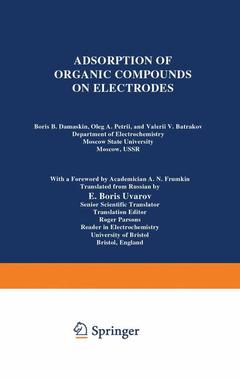Adsorption of Organic Compounds on Electrodes, Softcover reprint of the original 1st ed. 1971
Langue : Anglais
Auteur : Damaskin Boris

The systematic study of the adsorption of organic compounds on electrodes began with the comprehensive survey of adsorption on mercury carried out by Gouy in the first decade of this century. His studies with the capillary electrometer are still useful but do not lend themselves to detailed quantitative analysis. A more de tailed study of a few systems by Frumkin in his thesis (1919) led him to propose a quantitative phenomenological theory of organic adsorption (1925, 1926) at almost the same time as Stern proposed the model of the electrical double layer which remains the picture accepted in general terms today. The attempt at a molecular model made by Butler (1929) should be more satisfying but up to the pres ent the formidable difficulties of a molecular theory of interfacial phenomena have prevented the full interpretation of experimental results along these lines. In his work with Proskurnin (1935), Frumkin is also respon sible for the major experimental advance in the demonstration that reliable measurements of the capacity of an electrode-solution interface can be obtained provided that the work is carried out under conditions of scrupulous cleanliness. Even so, preCise mea surements of double layer capacities were not obtained until Grahame (1941) showed how convenient and reliable the dropping mercury electrode was the for these studies. This method and the hanging drop electrode remain the preferred methods for study of adsorp tion on mercury. Solid electrodes present a more difficult problem.
I. Absorption of Organic Compounds on Liquid Electrodes.- 1. Methods for Studying Adsorption of Organic Substances on Liquid Electrodes.- 2. Experiment Data on Adsorption of Organic Substances on Liquid Electrodes.- 3. Quantitative Theory of the Influence of an Electric Field on Adsorption of Organic Substances at a Mercury Electrode.- 4. Nonthermodynamic Methods for Calculating Adsorption of Organic Substances on Electrodes.- II. Adsorption of Organic Compounds on Solid Electrodes.- 5. Methods for Studying Adsorption of Organic Substances on Solid Electrodes.- 6. Adsorption of Organic Substances on Metals of High Hydrogen Overpotential.- 7. Adsorption of Organic Compounds on Metals of the Iron Group.- 8. Mechanism of Adsorption of Organic Compounds on Electrodes of Metals of the Platinum Group.- 9. Thermodynamics of Surface Phenomena on Electrodes Adsorbing Hydrogen and Oxygen.- 10. Relationships in Adsorption of Organic Compounds on Metals of the Platinum Group.
Date de parution : 02-2012
Ouvrage de 500 p.
15.2x22.9 cm
Thème d’Adsorption of Organic Compounds on Electrodes :
© 2024 LAVOISIER S.A.S.



